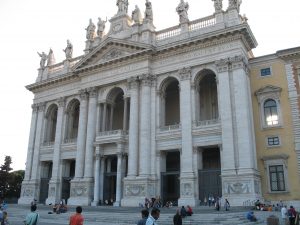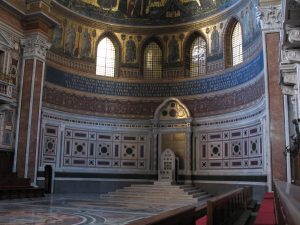WEEK 32 01 – Year II
Temples of the Holy Spirit
Feast: Dedication of the Lateran Basilica
(1 Cor 3:9-17; Ps 46; Jn 2:13-22)
**********************************************
The Basilica-Cathedral of St. John the Baptist in St. John’s, Newfoundland and Labrador is the metropolitan cathedral of the Roman Catholic Archdiocese of St. John’s, Newfoundland and the mother church and symbol of Roman Catholicism in Newfoundland. Bishop Emeritus Martin Currie showed me around his basilica when I was in St. John’s. I was very impressed by the architecture, the story of its construction, and especially the marble statue of the dead Christ within the altar.
That visit adds depth to the readings today, reminding us we are temples of the Holy Spirit, called to be sacred space where God dwells today and where others can encounter Jesus.

St John Lateran
Today we celebrate the dedication of the Basilica of St. John Lateran in Rome, the official seat of the Holy Father. The basilica’s stunning architecture, inlaid marble, colourful mosaics, and finely carved statues attract visitors from around the world. But it’s not the building’s beauty and majesty we celebrate today. It’s the “living stones” that have filled it over the centuries. It’s the faithful members of the Church whose hearts and minds are filled with Jesus and his Spirit.
It is the same with the basilica in St. John’s. It is not the architecture that is to be celebrated, but rather the living faith of the thousands of people who laboured for years to build it, who hauled away blasted rock to facilitate construction of the foundation, and hauled in quarried rocks, including cut limestone from Galway and granite from Dublin, Ireland, making up the edifice. It’s the faith of the four thousand Portugese sailors and their families who processed with the statue of Our Lady of Fatima through the streets to the basilica, and the faithful who still celebrate the Eucharist within its walls today that is to be celebrated. When consecrated on September 9, 1855, the Basilica’s cost was placed at half-a-million dollars, principally raised by the fishermen of the then country, an amazing testament to their enduring faith, and to the zeal of their bishop and clergy.
Another amazing basilica is central to the gospel, the colossal temple in Jerusalem at the time of Jesus. Build to replace the first temple constructed by King Solomon, this temple was for the Jews the dwelling place of God here on earth. However, as it was during the time of the first temple, the sacrificial system of Judaism had lost its way and devolved into a corrupt, self-serving religious system that was actually gouging the poor, who had to buy their sacrificial animals from the temple priests, a commerce taking place in the court of the gentiles making it actually impossible for them to come and pray. No wonder Jesus, upset at this irreverence and injustice, felt motivated to cleanse the temple.
In so doing, he was actually fulfilling one of the roles of the Messiah when he would come, to restore the Temple. In the time of Ezekiel, the temple worship had become so corrupt the Shekinah or glory of God that had filled the temple when it was dedicated, actually lifted up and abandoned the temple, heading East. Significantly, that shekinah or glory never returned when this second temple was dedicated, which always bothered the Pharisees especially, leading them to try to follow the Law perfectly so the glory of God would return.
I think Jesus would act in the same manner today when confronted with the abuse of power in the church, as well as the scandal of sexual abuse and cover-ups along with a tendency to prefer expensive beauty over concern for the poor in our midst.
When questioned about his radical behaviour that day, Jesus referred to the temple of his Body he would raise up on the third day. That of course would be his resurrection, when Jesus did restore the temple by rising from the dead through the power of the Holy Spirit. Not only that, the Shekinah or glory of God did return to the temple – not the physical structure in Jerusalem, but upon the small group of disciples gathered in the upper room at Pentecost in the form of tongues of fire and a strong wind that shook the whole building. This was the completion of the restoration of the new temple of God, the fledgling church, the new dwelling place of the Holy Spirit.
St Paul, in his letter to the Corinthians, invites us to let God show us who we truly are as temples of the Holy Spirit. Paul laid the foundation of the church which is Jesus Christ, and there is no other. However, he stresses we are God’s holy temple, and the Holy Spirit dwells within us. We are now the space where God comes and abides. The glory of the Lord shines through every window of our heart. Because we are his building, God depends on us. We are that warm and inviting place where other people can encounter Jesus.
Whenever I am asked to bless a new house, I always point out to the family the building is only a house – it is the love and life of a family dwelling within it that makes that house a home, warm and alive with laughter, stories, meals, hospitality and activities together. It is the same with us – it is our lively faith expressed through countless acts of love through forgiveness, reconciliation, communication, prayer, worship and selfless service that the new temple of God, the Church, truly becomes the dwelling place of God. That is our mission and task.

Papal chair
The central focus of any church and basilica is the altar, the lectern and the presider’s chair (in the case of the Lateran basilica, the chair of the pope), all symbolizing the presence of the Risen Lord among the new people of God. All are in play at every celebration of the Eucharist.
However, the most important presence of the Jesus is in the people, the faithful who gather. After all, we are the temples in which the Holy Spirit dwells. May our celebration today empower us to be faithful to St. Paul’s description of who we are and meant to be – sacred spaces where others can encounter Christ and become, in turn, temples of the Holy Spirit.



